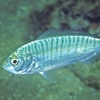General Description
Body robust, body tapering towards tail; head broadly flattened, snout pointed; dorsal and anal fins short-based, set far back on the body; tail base very short, caudal fin rounded; pelvic fins united into an obvious sucking disc on the underside; pectoral fins rounded; mouth small, almost tubular, lips prominent, with an obvious skinfold across snout. Alternating pale and darker wavy bands across the back and sides, bands variable in colour, from pale yellowish, brownish, pinkish or greenish, and sometimes with a dark stripe from snout, through eye and onto cheeks. To 8 cm.
Biology
This is the largest clingfish species in Port Phillip Bay. It hides under rocks and rubble around jetties and piers.
Habitat
On rocky reefs and rubble areas in bays, lagoons and along the coast, often under jetties and piers, in depths of 0-10 m.
Reefs
Distribution guide
Southern Australia.
Species Group
Fishes › Clingfishes and shore-eels
Depth
Shore (0-1 m)
Shallow (1-30 m)
Water Column
Max Size
8 cm
Commercial Species
No
Global Dispersal
Native to Australia
Identify
Conservation Status
- DSE Advisory List : Not listed
- EPBC Act 1999 : Not listed
- IUCN Red List : Not listed





